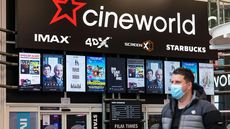Curtain up at Cineworld
Cineworld, the cinema chain, has shrugged off sector weakness and has room to grow, says Matthew Partridge.


Cinema chains have had a rough decade. Audiences have stagnated as people watch fewer films on the large screen and concentrate on television instead. There is constant pressure from studios either to shorten or scrap the 90-day window between a film's cinema release and its launch on streaming services (known as premium video on demand). Some streaming services, such as Amazon and Netflix, are even trying to get studios to skip a cinema release entirely and go straight to TV instead.
Nevertheless, the sector is hardly a write-off. While there has been a modest per-capita decline in the number of people attending cinemas, it is relatively limited, amounting to less than 1% a year per person in the United States. And thanks to more expensive tickets, overall revenue is still growing.
What's more, over the past year studios have backed away from accelerating film launches on premium video on demand after studies suggested this cannibalises rather than enhances revenue. Talk has shifted from eliminating the 90-day window to reducing it to 50 days, a recognition that a film's success on the big screen drives secondary sales.
Subscribe to MoneyWeek
Subscribe to MoneyWeek today and get your first six magazine issues absolutely FREE

Sign up to Money Morning
Don't miss the latest investment and personal finances news, market analysis, plus money-saving tips with our free twice-daily newsletter
Don't miss the latest investment and personal finances news, market analysis, plus money-saving tips with our free twice-daily newsletter
A resilient operator
One cinema chain that has defied the tough backdrop is Cineworld. Its strategy has been to invest in the latest technology, such as the bigger IMAX screens and wall-to-wall Superscreens, on the basis that if you're asking people to pay extra, you should give them something that isn't available at home.
It has also had a lot of success selling monthly memberships that permit unlimited visits, while the Picturehouse chain of cinemas focusing on arthouse and independent productions has diversified its range of films. Cineworld has delivered strong growth, more than doubling revenue between 2013 and 2017 while maintaining strong margins.
Its UK success bodes well for the recent $3.6bn takeover of Regal cinemas, one of the largest chains in the United States. Over the past five years Regal's market share has declined to around 20% (allowing plenty of room for expansion), and experts view its cinemas as outdated. Cinewold has pledged to turn Regal's fortunes around by investing in a refurbishment programme. It will also attempt to increase non-ticket revenue by boosting the amount of food and drink on offer (this currently accounts for a third of sales).
Despite the group's strong revenue growth and explosive share-price performance it trades at only 12.3 times forward earnings. Its 10% return on invested capital shows that it is squeezing value from the money that it puts into the business. Overall, we'd suggest buying Cineworld at its current price of 289p. We'd suggest that you buy it at £12 per 1p, compared with IG's minimum of £1. We'd put the stop loss at 209p, which will give you maximum downside of £960.
How my tips have fared
The slight recovery in the value of the FTSE 350 over the last fortnight has bolstered our long positions,with four out of the six stocks rising.
Greene King went up from 492p to 499p, Redrow rose to 558p from 500p, Shire is now at £45.57, up from £44.86. Next is at £51.96, compared with £50.51.
However, Premier Oil edged down from 109p to 107p, increasing our losses to £437.50, while Saga tumbled to 116p, down from 130p. Overall, Greene King and Shire are making money, while the rest of our long positions are in the red.
The bad news, however, is that while market conditions have boosted our longs, they have generally been bad for our shorts. With the exception of Netflix, which fell from $330 to $315, all the others went up in value.
In some cases, the rises were relatively minor, with bitcoin going up to $6,404 from $6,387, Snap increasing from $6.84 to $6.90, and Weis Markets also rising, from $44 to $44.60.
However, Tesla shot up from $261 to $341 after it shocked everybody by actually making a profit, thanks to income from carbon credits. Just Eat also jumped from 601p to 626p, while Twitter is now at $34.02.
Overall, while the losses on our longs have been reduced to £1,338, the profits on our shorts have shrunk to £1,392. This means our open positions are now just £54 in the black.
At present we have three open positions held for more than six months: Greene King, bitcoin and Tesla.
While we'd generally look to close any old positions that are making a loss, I'm going to give my Tesla short a reprieve although if things don't improve by the end of the year I'm definitely pulling the trigger. I'm also going to reduce the stop loss of bitcoin to $7,500.
Trading techniques: Dr Copper
Traders are always on the lookout for leading indicators that can provide advance warning of a recession and a downturn in the stockmarket. One of the most popular has always been the price of copper or "Dr Copper" as it's sometimes known. Because copper is needed for everything from batteries to the wiring inside houses and cars, if firms expect the economy to expand they will start to buy more copper in anticipation of increases in output. This will push prices higher. During an economic slowdown the process will go into reverse.
There is some evidence that copper consumption and global economic growth are linked.For example, Tom Wise of the Bank of England found a strong correlation between growth in global copper consumption and worldwide economic growth between 1981 and 2016. He also found that between 1999 and 2017 there was generally a strong three-year rolling correlation between metals prices and various measures of world activity.
However, copper's usefulness as a guide to the stockmarket, notably America's, has declined. Both copper and the S&P 500 collapsed in the second half of 2008, before rallying in early 2009. However, between February 2011 and early 2016 copper prices fell by more than half, while the S&P 500 went steadily up by more than 53%. Part of the reason for this is that the biggest consumer of copper is now China, which accounted for nearly half of world consumption in 2017. The decline of American manufacturing means that US copper consumption is only two-thirds of its 1998 level.
Matthew graduated from the University of Durham in 2004; he then gained an MSc, followed by a PhD at the London School of Economics.
He has previously written for a wide range of publications, including the Guardian and the Economist, and also helped to run a newsletter on terrorism. He has spent time at Lehman Brothers, Citigroup and the consultancy Lombard Street Research.
Matthew is the author of Superinvestors: Lessons from the greatest investors in history, published by Harriman House, which has been translated into several languages. His second book, Investing Explained: The Accessible Guide to Building an Investment Portfolio, is published by Kogan Page.
As senior writer, he writes the shares and politics & economics pages, as well as weekly Blowing It and Great Frauds in History columns He also writes a fortnightly reviews page and trading tips, as well as regular cover stories and multi-page investment focus features.
Follow Matthew on Twitter: @DrMatthewPartri
-
 Barclays warns of significant rise in social media investment scams
Barclays warns of significant rise in social media investment scamsInvestment scam victims are losing an average £14k, with 61% of those falling for one over social media. Here's how to spot one and keep your money safe
By Oojal Dhanjal Published
-
 Over a thousand savings accounts now offer inflation-busting rates – how long will they stick around?
Over a thousand savings accounts now offer inflation-busting rates – how long will they stick around?The rate of UK inflation slowed again in March, boosting the opportunity for savers to earn real returns on cash in the bank. But you will need to act fast to secure the best deals.
By Katie Williams Published
-
 Curtain falls as Cineworld files for bankruptcy
Curtain falls as Cineworld files for bankruptcyNews Cinema chain Cineworld is filing for bankruptcy in the US, and shareholders are likely to be wiped out. How did it come to this?
By Dr Matthew Partridge Published
-
 Cineworld faces a bleak future – investors should stay away
Cineworld faces a bleak future – investors should stay awayAnalysis Weighed down by crippling debts and with consumers tightening their belts, Cineworld's future does not look bright, says Rupert Hargreaves. Investors should steer well clear.
By Rupert Hargreaves Published
-
 Curtain up at Cineworld as lockdown ends, but threats remain
Curtain up at Cineworld as lockdown ends, but threats remainNews Cineworld’s shares rose as people returned to cinemas in their droves. But streaming companies such as Netflix and Amazon aren’t standing still. Matthew Partridge reports
By Dr Matthew Partridge Last updated
-
 The curtain comes down at Cineworld as it shuts all its cinemas
The curtain comes down at Cineworld as it shuts all its cinemasNews Cinema chain Cineworld is closing its operations in Britain and America. But this crisis is not due to Covid-19 – it is largely self-induced. Matthew Partridge reports
By Dr Matthew Partridge Published
-
Cineworld closure: don't blame James Bond, blame gearing
Advice The crisis at Cineworld shows why it’s important to pick healthier firms when betting on the recovery, says Cris Sholto Heaton.
By Cris Sholto Heaton Published
-
Cineworld heads to Canada with purchase of Cineplex
Features Cineworld's purchase of its Canadian rival Cineplex will allow it to tap the $770m annual revenues from the Canadian box office.
By Dr Matthew Partridge Published